A Short History of Allstate Single-Wheel Trailers
The following essay documents my attempts to research the history of the single-wheel trailers sold by Sear, Roebuck, and Company in the last century. It is by no means definitive, as there are several gaps which I hope to fill in by way of subsequent research. Any suggestions for additions or corrections would be very welcome!
The First Generation
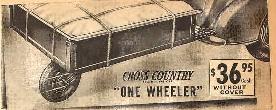
A single wheel trailer appeared in the Sears 1939 Spring catalog, evidently its debut there. This model was called the "Cross Country," a brand name it shared with a two-wheel trailer shown on the same page. It appears to have been in production only a year and a half. The catalog described it as having "Live Rubber Spring" suspension, touted as being longer lasting than metal coil springs. Its tongue arrangement was totally different from all later models, being straight pieces of metal sticking out of the front of the chassis and connected to the bumper by means of ball-and-socket couplings. (Extension arms could be bought if you needed more clearance between the car and the trailer.) The trailer, rated at 750 pounds of cargo capacity, sold for $36.95. It was made in Niles, Ohio unlike the "Cross Country" two-wheeled trailer which was made in Connorsville, Indiana.
They appear to be identical to the "Yocar" trailer made by the Youngstown Steel Car Corporation in Niles, Ohio, sharing the same frames and the same caster assembly with a rubber mount used as a coil spring would be. My conclusion is that that it was this company which supplied Sears with their first single-wheel trailers.
The chassis can be described as having a "Y within a Square" frame, with one brace connecting the arms of the Y and and two more supporting the base of the Y at the point where the caster wheel assembly connects.
The body appeared to be formed of wood panels within a steel frame, with a removable tailgate. It measured 54" long, 42" wide, and 11" high, including flare boards. The trailer could also be purchased without the box for $33.50.
The same trailer appeared in the Fall 1939 and Spring 1940 catalogs.
The Second Generation
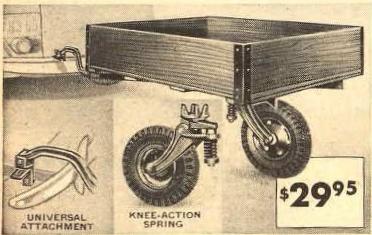 The Fall 1940 catalog showed a different trailer, with a "Knee action spring" (using a true coil-spring suspension) and the tongues that would become associated with Allstate trailers. These tongues were castings shaped into a sort of "question mark" shape and were designed to fit over a car's bumper and attach to either the bumper brackets or the car's frame. The box was 48" x 42" x 9-3/4", and appears to have been made of wood with "steel corner angles and four steel cross members," according to the catalog copy, but evidently not with the removable tailgate of the "Cross Country. It was rated for 500 pounds of cargo. This trailer came from a "factory in Chicago" and sold for $29.95
The Fall 1940 catalog showed a different trailer, with a "Knee action spring" (using a true coil-spring suspension) and the tongues that would become associated with Allstate trailers. These tongues were castings shaped into a sort of "question mark" shape and were designed to fit over a car's bumper and attach to either the bumper brackets or the car's frame. The box was 48" x 42" x 9-3/4", and appears to have been made of wood with "steel corner angles and four steel cross members," according to the catalog copy, but evidently not with the removable tailgate of the "Cross Country. It was rated for 500 pounds of cargo. This trailer came from a "factory in Chicago" and sold for $29.95
The earlier "Cross Country" trailer, with its 750 pound load capacity, was still available, with its Niles, Ohio source, and was priced at $37.95. The chassis-only option was still offered; its price was $34.50.
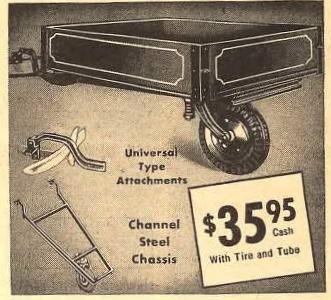 In the Spring 1941 catalog, the "Cross Country" trailer disappeared. Instead, the Chicago-made trailer was joined by another trailer from the same source in Chicago. This newest trailer was designed to replace the "Cross-Country" in the product line-up, since it was sold for around the same price and carried the same 750# load. It had a wooden box measuring 54" x 48 " x 9-3/4", using apparently the same construction as its little brother. The box differered not only in dimension but in its detailing, with an ornamental pattern painted in a different color than the main color of the panels.
In the Spring 1941 catalog, the "Cross Country" trailer disappeared. Instead, the Chicago-made trailer was joined by another trailer from the same source in Chicago. This newest trailer was designed to replace the "Cross-Country" in the product line-up, since it was sold for around the same price and carried the same 750# load. It had a wooden box measuring 54" x 48 " x 9-3/4", using apparently the same construction as its little brother. The box differered not only in dimension but in its detailing, with an ornamental pattern painted in a different color than the main color of the panels.
The new trailer also used a different frame, a trapezoidal "channel steel" chassis instead of the X-frame used on the smaller model.
The same "universal mount" tongues and new coil-spring suspension were used for both trailers. The prices were $29.95 and $34.95.
The Fall-Winter 1942 catalog showed the same two trailers with the same ordering numbers and specs, at slightly increased prices.
After this catalog, no single-wheel trailers show up in the catalog until 1948. I presume that they were discontinued for the duration of World War II, since manufacturing was devoted primarily to the war effort and things like steel and tires were in short supply. There was a kit offered in the Fall-Winter 1945 catalog for a four-wheel trailer, but no other utility trailers were offered.
The single-wheel trailer made its reappearance in the Fall 1948 Catalog. It appears to be the same as the larger of the trailers pictured in the 1942 catalogs, but it has a different stock number, a lowered load capacity (to 500#), and very slightly different dimensions. It, like the others, is described as coming from a Chicago factory. Its price is now $59.95, a full twenty dollars more than the large trailer offered in 1942.
These trailers bear a close resemblance to those offered by the Warshawsky Company of Chicago, Illinois in the fifties. These were marketed under the name "Trailcar" and I've heard that some of the castings on Allstate trailer tongues also bear the "Trailcar" name. The Trailcar Company began business in California but was moved to Chicago some time before the foll of 1948, when it was purchased by the Dunbar Kapple Company of Geneva, Illinois, Dunbar Kapple was to be a major supplier of single-wheel trailers to Sears, as we shall see.
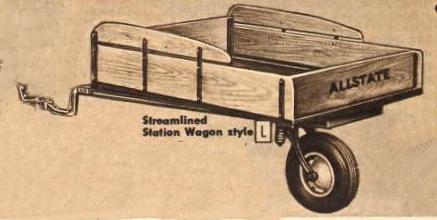 In the Fall 1949 catalog, another single-wheel trailer was added to the lineup. The two trailers seemed to share identical frames and load carrying capacity. They differed only in their cargo boxes. The new trailer was what Sears called a "station wagon" version, with two-piece sides. (A similar two-wheeled trailer had been made by Dunbar Kapple since around 1946.) The upper side-pieces were cut in a "streamlined" teardrop shape, separated from the lower pieces by a small gap. This body was varnished instead of painted, leaving the wood grain visible; the other body was painted blue.
In the Fall 1949 catalog, another single-wheel trailer was added to the lineup. The two trailers seemed to share identical frames and load carrying capacity. They differed only in their cargo boxes. The new trailer was what Sears called a "station wagon" version, with two-piece sides. (A similar two-wheeled trailer had been made by Dunbar Kapple since around 1946.) The upper side-pieces were cut in a "streamlined" teardrop shape, separated from the lower pieces by a small gap. This body was varnished instead of painted, leaving the wood grain visible; the other body was painted blue.
One of these trailers was probably the model 231-508 ("Formerly Model Nos. 249.8074, 249.8075 and 327.6215") described in a parts list ca 1951. It's the standard version, not the "station wagon" version.
The spring 1953 catalog shows the same two trailers. The prices are now $66.50 and $71.50 for the older and newer versions, respectively.
In the Fall 1953 catalog, only the prices have changed, each model now costing a dollar more.
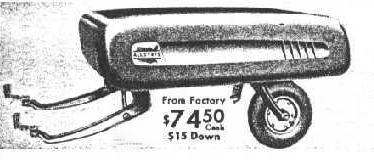 There is a page on the singlewheel.com site that purports to show a Spring 1955 Sears catalog, showing only the all-metal trailer described in the next paragraph and no wood-body trailer at all. However, the year is hand-written in, and the top part is missing, so it could be a different year altogether. The stock number of the trailer is 28KM6155F, from Chicago, and the price is listed as $109.50, which would put it around 1959, not 1955). This catalog page shows what is unmistakably the all-metal body with a price of $69.50, marked down from $74.50 The stock number is 28KM6199F. This catalog marks the first appearance I can find of the steel-box single-wheel Allstate trailer popularly known as the "Tag-along" trailer (although I could find no indication that Sears ever called it by that name). Since the retail price is only slightly below that of the 1956 catalog, the date ascribed to the circular seems reasonable. It seems to have shared the same wheel assembly with the other trailer, but has a different tongue arrangement, with the new tongues being longer and designed to fit only underneath the bumper. Its load capacity was also 500#.
There is a page on the singlewheel.com site that purports to show a Spring 1955 Sears catalog, showing only the all-metal trailer described in the next paragraph and no wood-body trailer at all. However, the year is hand-written in, and the top part is missing, so it could be a different year altogether. The stock number of the trailer is 28KM6155F, from Chicago, and the price is listed as $109.50, which would put it around 1959, not 1955). This catalog page shows what is unmistakably the all-metal body with a price of $69.50, marked down from $74.50 The stock number is 28KM6199F. This catalog marks the first appearance I can find of the steel-box single-wheel Allstate trailer popularly known as the "Tag-along" trailer (although I could find no indication that Sears ever called it by that name). Since the retail price is only slightly below that of the 1956 catalog, the date ascribed to the circular seems reasonable. It seems to have shared the same wheel assembly with the other trailer, but has a different tongue arrangement, with the new tongues being longer and designed to fit only underneath the bumper. Its load capacity was also 500#.
This all-metal trailer appears identical to one sold in the 1950s by Dunbar Kapple, a trailer manufacturer in Geneva, Illinois, about thirty miles west of Chicago. (Dunbar Kapple was said to be partially owned by Sears.) The model number of the Allstate trailer was 231-963. Under Sears's numbering system, the first three digits indicated the manufacturer, and it happens that this prefix was also used for Sears two-wheel trailers sold under the David Bradley marque (David Bradley was the Sears marque for the agricultural equipment they sold.) So the evidence suggests that Dunbar Kapple made the single-wheel trailer as well.
The next Sears catalog I could locate was the Spring 1956 catalog. In this issue, the "station wagon" version has been dropped, but the original version, with the blue-painted wood cargo box, has been retained and now sells for $69.95. The all-metal trailer now sold for $77.50.
If you had a 1955 Chevrolet, there was a version specifically for that model, but it isn't stated what the differences were. I would presume it used a variant of the bumper mounting hardware.
The Spring 1957 catalog shows the same two trailers, with the inevitable prices increases to $76.50 and $89.50. Again, Chevrolet owners are asked to note that on the order forms, so they can receive the proper trailer hitch configuration.
The Fall 1957 catalog shows the same trailers, with separate model numbers for the versions that are used with 1956 and 1957 Chevrolets.
In the 1960 catalog, the all-metal streamlined trailer is gone. Only the original version remains in the catalog, with a price of $77.00. Since the cargo box is described only as "dark blue," it's not clear whether this a wood or metal body. Although the trailer is still described as being made in Chicago, both the stock number and the shipping weight are different.
Model numbers for streamlined metal (aka "Tagalong")
231-963 ("1956 or 1957")
231-96369 (found in Canada)
The Third Generation
 the third generation made its debut in the 1961 catalog. this one used a totally different tongue arrangement, using simple flat stock bent in two places. it also sported a different suspension system consisting of twin leaf-spring assemblies. the bottom leaves extended much farther out than the others, and bore l-brackets to which the axle of the wheel was attached. the cargo box was wood, and like the other trailers, the cargo load was 500#. the trailer was now made "near des moines, iowa" and sold for $89.95 from the factory. I have learned that this factory was the Ideal Manufacturing Company, based in Oscaloosa, Iowa. In the 1980s, this company was absorbed into Superior Industries International, now based in Van Nuys, California, but this was long after Ideal stopped making trailers.
the third generation made its debut in the 1961 catalog. this one used a totally different tongue arrangement, using simple flat stock bent in two places. it also sported a different suspension system consisting of twin leaf-spring assemblies. the bottom leaves extended much farther out than the others, and bore l-brackets to which the axle of the wheel was attached. the cargo box was wood, and like the other trailers, the cargo load was 500#. the trailer was now made "near des moines, iowa" and sold for $89.95 from the factory. I have learned that this factory was the Ideal Manufacturing Company, based in Oscaloosa, Iowa. In the 1980s, this company was absorbed into Superior Industries International, now based in Van Nuys, California, but this was long after Ideal stopped making trailers.
(On my trailer which is identical to this trailer in most respects, the earliest "year" sticker on the original plate was 1965 So my guess is that it was purchased sometime up to a year before then. I might add that when I bought the trailer, it had a cargo box that had been added by a previous owner, not the original box. It also had a folding-leg arrangement and an extra set of tension springs on the axle, neither of which were used by Ideal for their trailers. Unfortunately, the VIN plate was missing on my trailer, so I have no information as to model or serial numbers.)
The next catalog I was able to find was the Fall 1967 catalog, which showed a trailer identical to the early 1960s trailer, except that it now had a metal box instead of a wooden one. (The picture above shows the 1967 version.) It sold for $96.95, with an optional metal top selling for $41.95.
The Spring 1968 catalog carried the same information. In the Fall catalog of that year, the price is increased to $109.95, with the optional top selling for $44.95.
In the 1972 Spring catalog, the price of the trailer jumped to $154.95. The optional top was no longer available. The body was painted "cinnamon brown" instead of white, and it bore a new stock number.
In the Spring and Fall 1973 Catalogs, the price was $159.95, and in the Spring and Fall 1974 catalogs it was $164.95. But in the Spring 1975 issue, the price soared to $224.95. That price remained in effect until the Fall 1975 catalog, the last catalog to list the single-wheel trailer.
I have identified some of the model numbers for this style of trailer; they are 287.61830; 287.61530; 287.61961 (described as a "1965 Allstate Single-Wheel Trailer"); and 287-61660 (found on a wood-box version on singlewheel.com Allstate wood-box page, evidently from New Mexico)
 In the Spring 1941 catalog, the "Cross Country" trailer disappeared. Instead, the Chicago-made trailer was joined by another trailer from the same source in Chicago. This newest trailer was designed to replace the "Cross-Country" in the product line-up, since it was sold for around the same price and carried the same 750# load. It had a wooden box measuring 54" x 48 " x 9-3/4", using apparently the same construction as its little brother. The box differered not only in dimension but in its detailing, with an ornamental pattern painted in a different color than the main color of the panels.
In the Spring 1941 catalog, the "Cross Country" trailer disappeared. Instead, the Chicago-made trailer was joined by another trailer from the same source in Chicago. This newest trailer was designed to replace the "Cross-Country" in the product line-up, since it was sold for around the same price and carried the same 750# load. It had a wooden box measuring 54" x 48 " x 9-3/4", using apparently the same construction as its little brother. The box differered not only in dimension but in its detailing, with an ornamental pattern painted in a different color than the main color of the panels.

 The Fall 1940 catalog showed a different trailer, with a "Knee action spring" (using a true coil-spring suspension) and the tongues that would become associated with Allstate trailers. These tongues were castings shaped into a sort of "question mark" shape and were designed to fit over a car's bumper and attach to either the bumper brackets or the car's frame. The box was 48" x 42" x 9-3/4", and appears to have been made of wood with "steel corner angles and four steel cross members," according to the catalog copy, but evidently not with the removable tailgate of the "Cross Country. It was rated for 500 pounds of cargo. This trailer came from a "factory in Chicago" and sold for $29.95
The Fall 1940 catalog showed a different trailer, with a "Knee action spring" (using a true coil-spring suspension) and the tongues that would become associated with Allstate trailers. These tongues were castings shaped into a sort of "question mark" shape and were designed to fit over a car's bumper and attach to either the bumper brackets or the car's frame. The box was 48" x 42" x 9-3/4", and appears to have been made of wood with "steel corner angles and four steel cross members," according to the catalog copy, but evidently not with the removable tailgate of the "Cross Country. It was rated for 500 pounds of cargo. This trailer came from a "factory in Chicago" and sold for $29.95  In the Fall 1949 catalog, another single-wheel trailer was added to the lineup. The two trailers seemed to share identical frames and load carrying capacity. They differed only in their cargo boxes. The new trailer was what Sears called a "station wagon" version, with two-piece sides. (A similar two-wheeled trailer had been made by Dunbar Kapple since around 1946.) The upper side-pieces were cut in a "streamlined" teardrop shape, separated from the lower pieces by a small gap. This body was varnished instead of painted, leaving the wood grain visible; the other body was painted blue.
In the Fall 1949 catalog, another single-wheel trailer was added to the lineup. The two trailers seemed to share identical frames and load carrying capacity. They differed only in their cargo boxes. The new trailer was what Sears called a "station wagon" version, with two-piece sides. (A similar two-wheeled trailer had been made by Dunbar Kapple since around 1946.) The upper side-pieces were cut in a "streamlined" teardrop shape, separated from the lower pieces by a small gap. This body was varnished instead of painted, leaving the wood grain visible; the other body was painted blue.
 There is a page on the singlewheel.com site that purports to show a Spring 1955 Sears catalog, showing only the all-metal trailer described in the next paragraph and no wood-body trailer at all. However, the year is hand-written in, and the top part is missing, so it could be a different year altogether. The stock number of the trailer is 28KM6155F, from Chicago, and the price is listed as $109.50, which would put it around 1959, not 1955). This catalog page shows what is unmistakably the all-metal body with a price of $69.50, marked down from $74.50 The stock number is 28KM6199F. This catalog marks the first appearance I can find of the steel-box single-wheel Allstate trailer popularly known as the "Tag-along" trailer (although I could find no indication that Sears ever called it by that name). Since the retail price is only slightly below that of the 1956 catalog, the date ascribed to the circular seems reasonable. It seems to have shared the same wheel assembly with the other trailer, but has a different tongue arrangement, with the new tongues being longer and designed to fit only underneath the bumper. Its load capacity was also 500#.
There is a page on the singlewheel.com site that purports to show a Spring 1955 Sears catalog, showing only the all-metal trailer described in the next paragraph and no wood-body trailer at all. However, the year is hand-written in, and the top part is missing, so it could be a different year altogether. The stock number of the trailer is 28KM6155F, from Chicago, and the price is listed as $109.50, which would put it around 1959, not 1955). This catalog page shows what is unmistakably the all-metal body with a price of $69.50, marked down from $74.50 The stock number is 28KM6199F. This catalog marks the first appearance I can find of the steel-box single-wheel Allstate trailer popularly known as the "Tag-along" trailer (although I could find no indication that Sears ever called it by that name). Since the retail price is only slightly below that of the 1956 catalog, the date ascribed to the circular seems reasonable. It seems to have shared the same wheel assembly with the other trailer, but has a different tongue arrangement, with the new tongues being longer and designed to fit only underneath the bumper. Its load capacity was also 500#.
 the third generation made its debut in the 1961 catalog. this one used a totally different tongue arrangement, using simple flat stock bent in two places. it also sported a different suspension system consisting of twin leaf-spring assemblies. the bottom leaves extended much farther out than the others, and bore l-brackets to which the axle of the wheel was attached. the cargo box was wood, and like the other trailers, the cargo load was 500#. the trailer was now made "near des moines, iowa" and sold for $89.95 from the factory. I have learned that this factory was the Ideal Manufacturing Company, based in Oscaloosa, Iowa. In the 1980s, this company was absorbed into Superior Industries International, now based in Van Nuys, California, but this was long after Ideal stopped making trailers.
the third generation made its debut in the 1961 catalog. this one used a totally different tongue arrangement, using simple flat stock bent in two places. it also sported a different suspension system consisting of twin leaf-spring assemblies. the bottom leaves extended much farther out than the others, and bore l-brackets to which the axle of the wheel was attached. the cargo box was wood, and like the other trailers, the cargo load was 500#. the trailer was now made "near des moines, iowa" and sold for $89.95 from the factory. I have learned that this factory was the Ideal Manufacturing Company, based in Oscaloosa, Iowa. In the 1980s, this company was absorbed into Superior Industries International, now based in Van Nuys, California, but this was long after Ideal stopped making trailers.